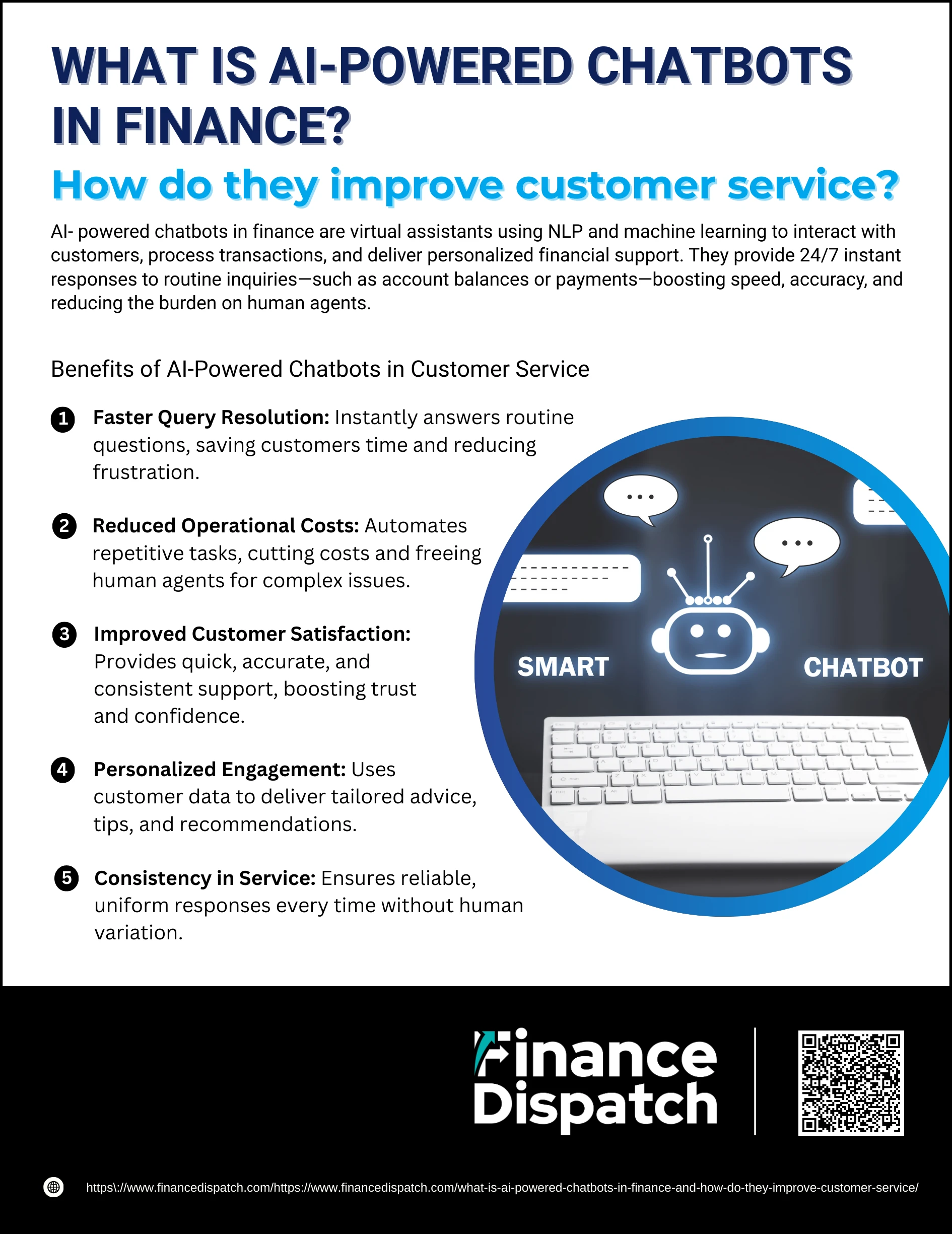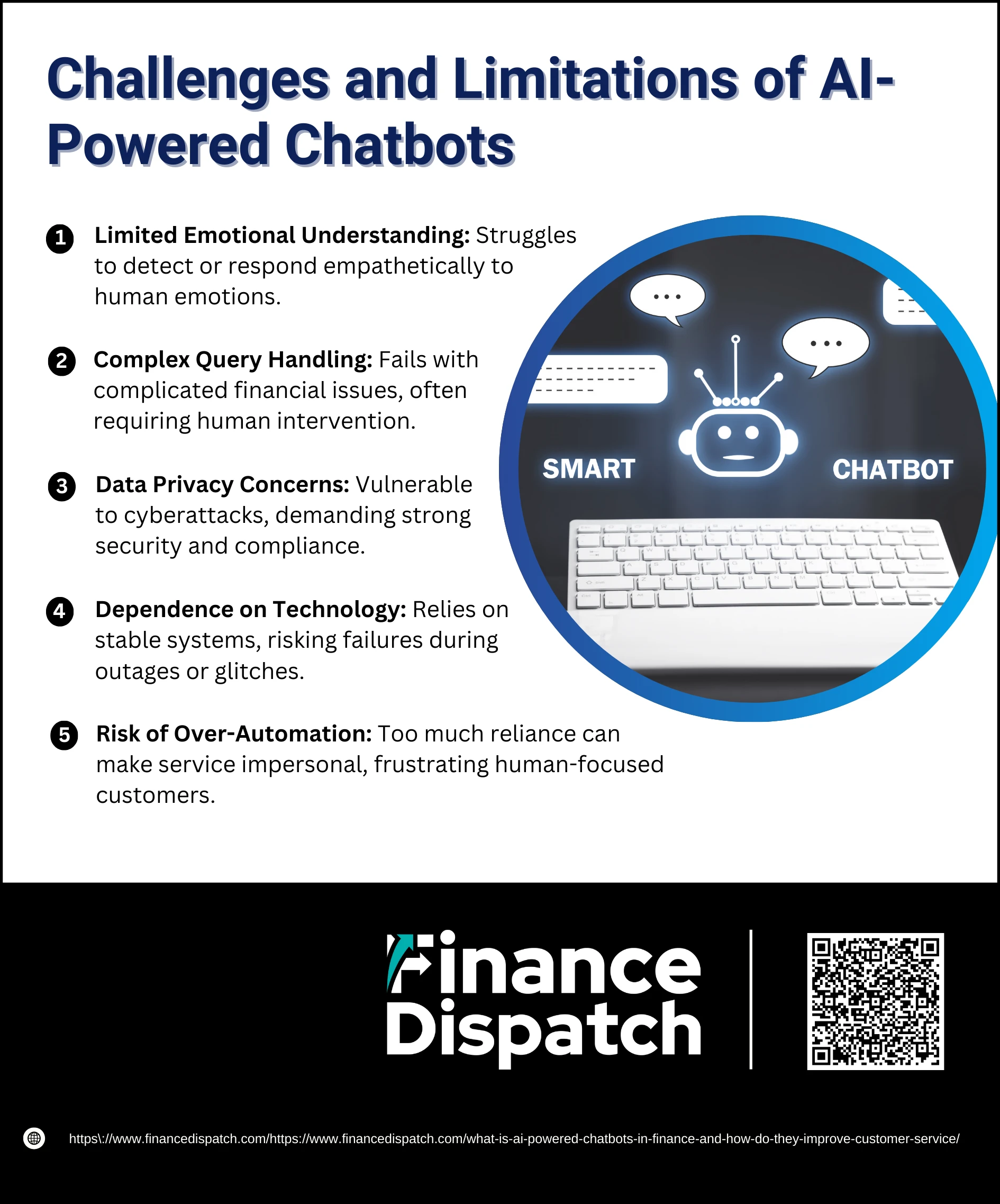In today’s fast-paced financial world, customer expectations are higher than ever. People want instant answers, personalized guidance, and seamless support—whether they’re checking their account balance, filing an insurance claim, or asking about investment options. This is where AI-powered chatbots are transforming the finance industry. Unlike traditional chatbots that rely on rigid scripts, these intelligent virtual assistants use artificial intelligence (AI) and natural language processing (NLP) to understand customer queries, provide accurate responses, and even learn from past interactions. By combining speed, availability, and personalization, AI chatbots are helping banks, insurers, and fintech companies deliver a new level of customer service that is more efficient, cost-effective, and customer-friendly.
What are AI-Powered Chatbots in Finance?
AI-powered chatbots in finance are intelligent virtual assistants designed to interact with customers just like a human representative, but with the speed and efficiency of artificial intelligence. They use technologies such as machine learning and natural language processing (NLP) to understand questions, analyze context, and deliver accurate responses. Unlike traditional chatbots that follow fixed scripts, AI chatbots continuously learn from customer interactions, making them more adaptable and capable of handling complex queries. In the financial sector, these chatbots are integrated into banking apps, websites, and customer service platforms to help users check balances, transfer money, track spending, or even receive personalized financial advice. By bridging the gap between automation and personalized service, they are redefining how financial institutions engage with their customers.
Key Features of AI Chatbots in Finance
AI chatbots in finance come equipped with advanced features that make them far more effective than traditional customer support tools. They not only respond quickly but also deliver personalized, accurate, and secure assistance, which is vital in the financial industry.
1. Natural Language Processing (NLP): Understands customer queries in everyday language, making interactions smooth and intuitive.
2. 24/7 Availability: Offers round-the-clock support, ensuring customers get help anytime they need it.
3. Personalized Financial Guidance: Provides tailored advice based on transaction history, spending habits, and user behavior.
4. Fraud Detection & Alerts: Monitors unusual account activity and instantly notifies customers of potential risks.
5. Multichannel Support: Integrates across apps, websites, and messaging platforms for a seamless user experience.
6. Scalability: Handles thousands of customer interactions simultaneously without compromising response quality.
 Benefits of AI-Powered Chatbots in Customer Service
Benefits of AI-Powered Chatbots in Customer Service
AI-powered chatbots are redefining customer service in finance by combining automation with intelligence. They handle routine requests, offer personalized recommendations, and even alert customers about potential risks—all while working faster and at a lower cost than traditional support teams. Here’s how they make a real difference:
1. Faster Query Resolution
Customers no longer need to wait in long call center queues. Chatbots can instantly respond to questions like balance inquiries, transaction details, or loan eligibility, providing quick solutions within seconds. This speed not only saves time but also reduces frustration.
2. Reduced Operational Costs
Financial institutions save significantly by automating repetitive tasks such as FAQs and simple transactions. Instead of hiring large teams to handle these queries, chatbots manage them efficiently, allowing human agents to focus on complex cases.
3. Improved Customer Satisfaction
When customers receive quick, accurate, and helpful responses, their trust and confidence in the institution grow. By being available anytime and maintaining consistency, chatbots help improve the overall service experience.
4. Personalized Engagement
AI chatbots use customer data—like spending patterns, previous queries, and financial goals—to tailor their responses. For example, they might suggest savings tips or offer relevant investment advice based on the customer’s profile.
5. Consistency in Service
Unlike human agents who may vary in tone, mood, or accuracy, chatbots deliver uniform responses every time. This ensures that customers get the same reliable experience, whether it’s their first query or their fiftieth.
Real-World Applications in the Finance Industry
AI-powered chatbots are widely adopted in the financial sector to simplify complex processes and make customer interactions faster and more convenient. From banking to insurance, they play a crucial role in improving efficiency while reducing dependency on human agents. Here are some key applications:
1. Banking Services: Customers can use chatbots to check balances, transfer funds, review recent transactions, or reset their PINs—all without waiting in line or calling a support center. This convenience makes banking more accessible, especially for people who prefer digital-first solutions.
2. Insurance Support: Chatbots guide customers through the insurance journey by answering questions about policy details, sending reminders for premium payments, and even initiating claims. This helps reduce paperwork and provides clarity during stressful times, such as accidents or emergencies.
3. Investment Assistance: AI chatbots provide personalized portfolio updates, real-time market insights, and tailored investment suggestions. They act like a virtual financial advisor, making wealth management more approachable for both beginners and experienced investors.
4. Fraud Monitoring & Alerts: By analyzing unusual activity in real time, chatbots can detect suspicious transactions and immediately notify customers. This proactive approach not only prevents potential losses but also builds customer trust in financial security.
5. Payments & FinTech: In mobile wallets and fintech apps, chatbots send bill reminders, confirm payments, and help users track spending patterns. This makes financial management easier and keeps customers engaged with the platform.
 Challenges and Limitations of AI-Powered Chatbots
Challenges and Limitations of AI-Powered Chatbots
AI-powered chatbots have brought speed, scalability, and efficiency to financial services, but they aren’t perfect. Many limitations still exist, and these issues highlight why human agents remain a critical part of customer service in finance. Below are the key challenges:
1. Limited Emotional Understanding
While AI chatbots can process words and provide logical responses, they struggle to pick up on human emotions such as anger, stress, or empathy. For example, when a customer reports a lost credit card in a panic, a chatbot may give factual instructions but fail to show compassion. This lack of emotional intelligence can make interactions feel cold and unsatisfactory.
2. Complex Query Handling
Chatbots excel at routine tasks like balance checks or transaction updates, but they often fail when faced with complicated financial queries. Questions about tax rules, multi-step loan processes, or disputes involving multiple transactions usually require human judgment. In such cases, customers are transferred to live agents, which can cause delays.
3. Data Privacy Concerns
Since chatbots handle sensitive financial data, they are prime targets for cyberattacks. Any breach in security could expose customer account details, personal information, or transaction history. This makes it essential for institutions to maintain strong encryption, secure APIs, and compliance with regulations such as GDPR or PCI DSS.
4. Dependence on Technology
AI chatbots rely heavily on stable internet connections, cloud servers, and integrated systems. If there’s a system outage, slow network, or software glitch, customer interactions can break down instantly. Such interruptions not only frustrate users but can also harm the financial institution’s reputation.
5. Risk of Over-Automation
While automation reduces costs, excessive reliance on chatbots can alienate customers who prefer speaking to humans for reassurance. For instance, elderly customers or those facing stressful financial situations often value empathy and trust that only a human can provide. A fully automated approach can make service feel impersonal and transactional.
AI Chatbots vs. Human Support – A Comparison
Both AI chatbots and human agents play important roles in financial customer service, but their strengths and weaknesses differ. Chatbots excel in speed, cost efficiency, and round-the-clock availability, while humans bring empathy, critical thinking, and the ability to resolve complex issues. A balanced approach often delivers the best customer experience.
| Aspect | AI Chatbots | Human Support |
| Availability | 24/7 instant responses across multiple channels | Limited to working hours and availability |
| Response Speed | Provides answers in seconds for routine queries | May involve wait times or call queues |
| Cost Efficiency | Reduces staffing needs, highly scalable | Higher operational and staffing costs |
| Personalization | Data-driven, tailored recommendations | Emotion-driven, empathetic personalization |
| Complex Issues | Struggles with highly complex or unique queries | Strong ability to resolve nuanced cases |
| Consistency | Delivers uniform responses every time | May vary depending on agent experience |
| Customer Experience | Efficient but sometimes impersonal | Builds trust through empathy and rapport |
Future of AI-Powered Chatbots in Finance
The future of AI-powered chatbots in finance looks promising as advancements in artificial intelligence, natural language processing, and predictive analytics continue to evolve. Chatbots are expected to move beyond basic query handling to deliver hyper-personalized financial guidance, such as helping customers plan budgets, manage investments, and detect fraud before it happens. Voice-enabled banking assistants, multilingual support, and deeper integration with mobile apps will make financial services even more accessible to diverse customer groups. Moreover, as emotional AI improves, chatbots may begin to understand customer moods and respond with empathy, bridging one of the current gaps between machines and humans. Ultimately, financial institutions are likely to adopt hybrid models, where AI handles routine interactions while human agents focus on complex and sensitive cases, creating a more efficient and customer-centric service environment.
Conclusion
AI-powered chatbots are reshaping the financial services industry by making customer support faster, smarter, and more efficient. From handling everyday banking tasks to providing personalized advice and fraud alerts, these intelligent assistants are helping institutions meet rising customer expectations while keeping costs under control. However, they are not without limitations—issues such as emotional understanding, complex queries, and privacy concerns highlight the continued need for human support. The future lies in a balanced approach where AI and human agents work together, ensuring financial services remain both innovative and customer-focused.



